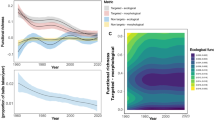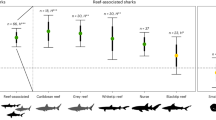Abstract
Harbour seals (Phoca vitulina ), like many phocid species, forage to some extent at night1. Although nocturnal mammals typically rely on non-visual sensory channels, seals have adapted to low light levels by sharpening their visual sense2. Although enhanced visual sensitivity would be functional in clear water, many species inhabit turbid coastal or estuarine regions where vision is sometimes of limited use even in daylight. Here we present experimental evidence in support of the contention that when visual cues are not available, seals use echolocation. Our results help to explain why previous attempts to demonstrate sonar abilities in pinnipeds have been unsuccessful.
This is a preview of subscription content, access via your institution
Access options
Subscribe to this journal
Receive 51 print issues and online access
$199.00 per year
only $3.90 per issue
Buy this article
- Purchase on Springer Link
- Instant access to full article PDF
Prices may be subject to local taxes which are calculated during checkout
Similar content being viewed by others
References
Hobson, E. Nature 210, 326–327 (1966).
Wartzok, D. Phocid Spectral Sensitivity Curves, 62 Abstr. 3rd. Biennial Conf. Biology of Marine Mammals, Seattle, Washington (1979).
Norris, K. in The Biology of Marine Mammals (ed. Anderson, H.) (Academic, London, 1969).
Renouf, D., Galway, G. & Gaborko, L. J. mar. biol. Ass. U.K. 60, 1039–1042 (1980).
Poulter, R. in The Behavior and Physiology of Pinnipeds (eds Harrison, R., Hubbard, R., Peterson, R., Rice, C. & Schusterman, R.) (Appleton Century Crofts, New York, 1968).
Evans, W. & Haugan, R. Bull. Sth. Calif. Acad. Sci. 62, 165–175 (1963).
Schusterman, R. in Animal Sonar Systems: Biology and Bionics (ed. Busnel, R.) (Laboratoire de Physiologic Acoustique, Jouy-en-Josas, France, 1967).
Scronce, B. & Ridgway, S. in Animal Sonar Systems (eds Busnel, R. & Fish, J.) (Plenum, London, 1980).
Author information
Authors and Affiliations
Rights and permissions
About this article
Cite this article
Renouf, D., Davis, M. Evidence that seals may use echolocation. Nature 300, 635–637 (1982). https://doi.org/10.1038/300635a0
Received:
Accepted:
Issue Date:
DOI: https://doi.org/10.1038/300635a0
This article is cited by
-
Seal echolocation?
Nature (1984)
-
Seal echolocation? (reply)
Nature (1984)
Comments
By submitting a comment you agree to abide by our Terms and Community Guidelines. If you find something abusive or that does not comply with our terms or guidelines please flag it as inappropriate.



